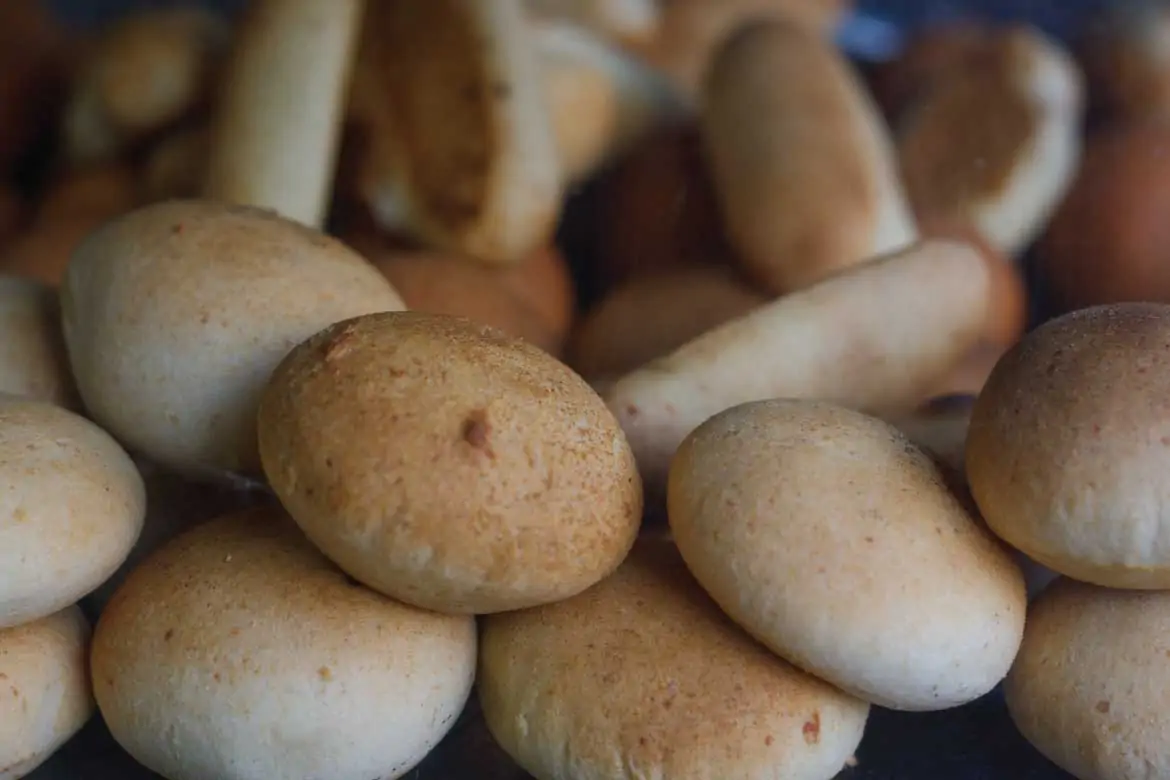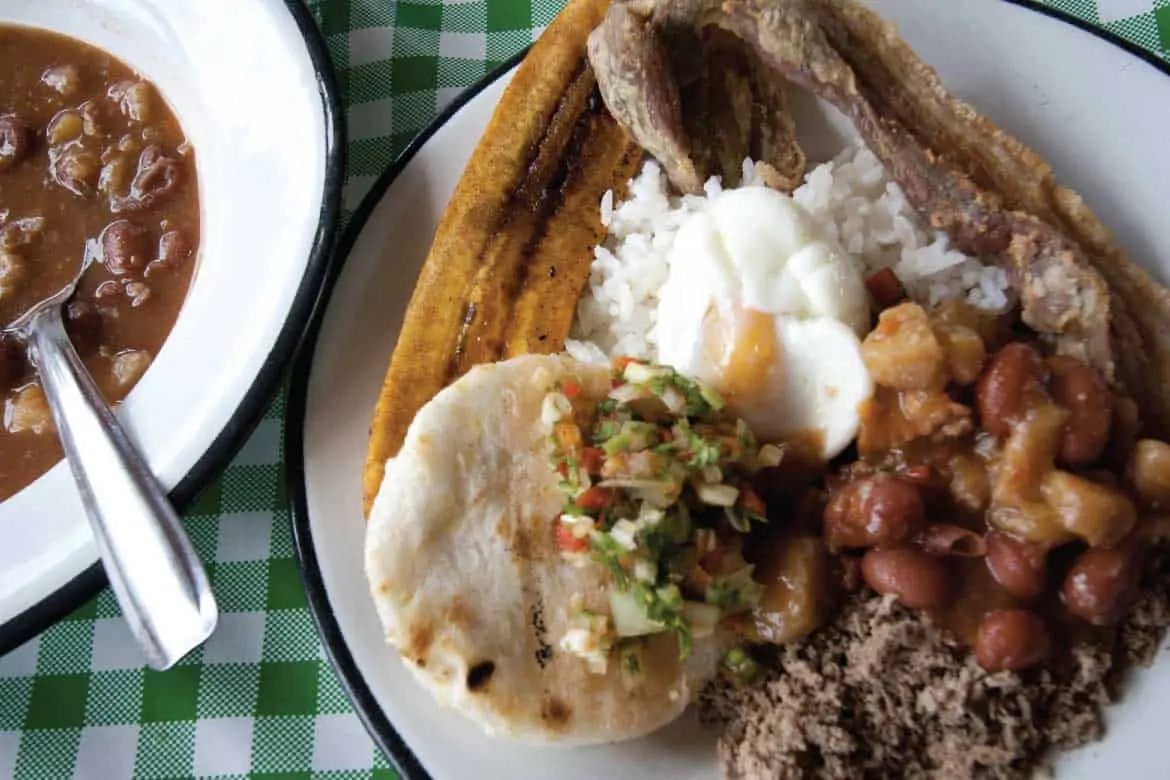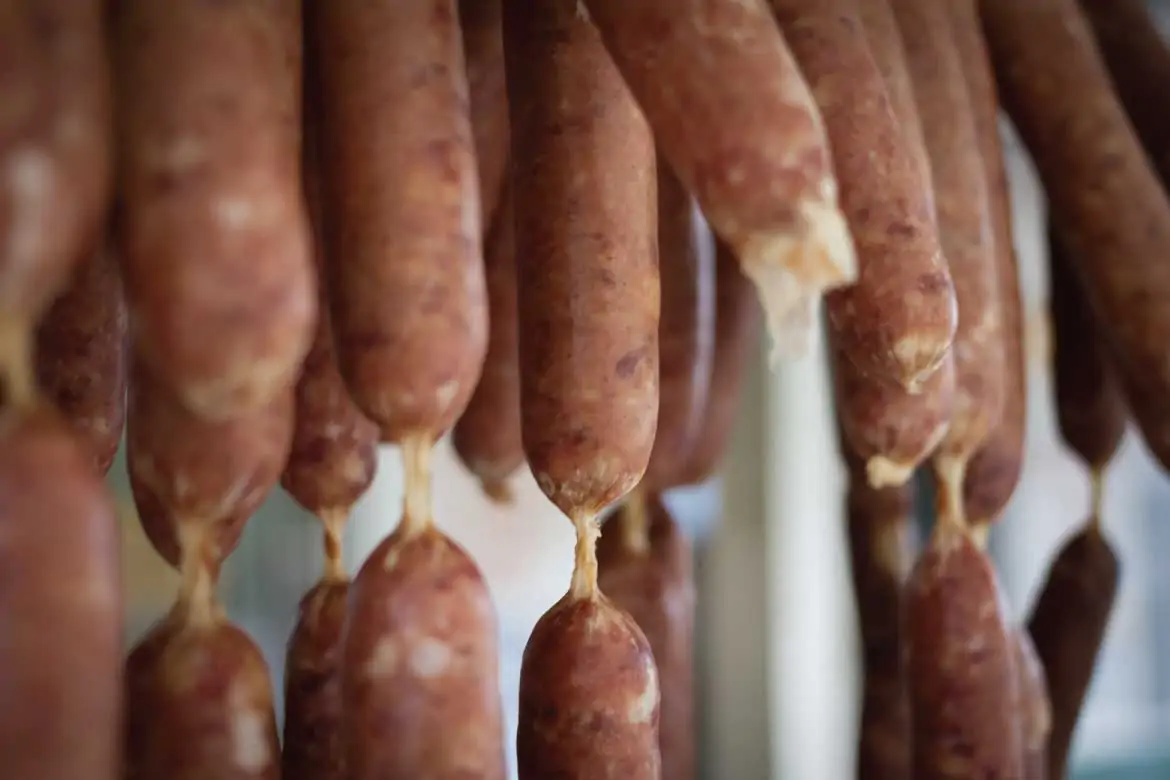Food & drink glossary
A is for Achira, B is for Bandeja paisa, C is for Caldo de Costilla. Our list of 101 food and drink terms used in Colombia.
- Achira: Small oval shaped savoury biscuits, made from cheese curds. From the Huila department
- Aguapanela: Raw cane sugar dissolved in hot water, sometimes with added lime
- Aguardiente: Colombian aniseed flavoured fire water, especially popular in the Andean region
- Ají casero: The perfect sauce for your empanadas, made with chilli ,finely chopped onion and coriander
- Ajiaco santafereño: A popular potato and herb soup from the Bogotá savannah, normally served with chicken, corn, capers, cream and avocado
- Al ajillo: A buttery garlic sauce for fish, especially common in the Caribbean
- Alfajor: The alfajor is an escapee from Argentina & Chile that has made its way to the cafés of Colombia. Two butter biscuits glued together with dulce de leche then dusted with sugar or coated in chocolate
- Almojábana: A bread made of corn meal, wheat flour, eggs, cheese and sugar
- Arepa: Any number of regional variations of corn patties made with white or yellow maize meal or sweetcorn, sometimes stuffed with cheese
- Arepizza: A pizza with an arepa for its base
- Arequipe: The Colombian name for dulce de leche, see also manjar blanco
- Aromática: An infusion of aromatic herbs, often sweetened with panela or syrup, sometimes a shot of aguardiente is added
- Arroz con Coca Cola: Rice cooked in Coca Cola, who came up with that?
- Arroz con coco: A Caribbean accompaniment, rice cooked with coconut
- Avena helada: A chilled drink mixture of boiled oats, water, milk, cinnamon and salt.
- Ayahuasca: Also known as yagé or yajé. Ayahuasca is a psychoactive indigenous herbal infusion common to the Amazonas and Putumayo departments of Colombia
- Bandeja paisa: The most famous dish from Antioquia. A huge tray of fried meats and plantain served with rice, beans, avocado and a fried egg
- Bocadillo de guayaba: Very similar to Spanish dulce de membrillo but made with guava instead of quinces, coated in sugar and often eaten with cheese
- Bofe: Beware the bofe, it is pigs’ lungs and definitely an acquired taste, although we are yet to meet anyone that has acquired said taste
- Buñuelo: Perfectly spherical fried cheesy dough balls, about the size of a tennis ball
- Caldo de costilla: A clear broth made with beef short ribs, a common breakfast
- Campesino: An adjective used to impart a rustic “countryside” quality in foods, campesino coffee is made with cloves, cinnamon and panela, campesino bread is less perfectly shaped and campesino cheese you could probably make in a tin bath on a hot afternoon
- Canelazo: Aguapanela with the addition of cinnamon and aguardiente
- Carne llanera: Beef barbecued on a conical rack over logs, a cooking method from Los Llanos
- Cervecero: A highly seasoned sausage eaten in slices
- Cerveza a colores: Beer with food colouring in it. Now why would they do that?
- Cerveza michelada: A Colombian take on a Mexican classic, beer served with lime juice in a tall glass with a salted rim
- Ceviche: A far cry from its Peruvian cousin, Colombian ceviche is simply shrimps and chopped onion served in ketchup. Normally accompanied by soda crackers
- Changua: A soup of milk, eggs and scallions
- Chicharrón: Fried pork cracking, available in a big chunk with your lunch or in a dry form in packs
- Chisquey: A mis-spelling of cheesecake
- Chocoramo: A tablet of long-life cake coated in approximately 4 microns of chocolate effect veneer. A triumph of engineering over flavour but popular with Colombian children
- Chocolate con queso: Another typical Colombian breakfast, yes it’s chocolate and cheese and yes, you are expected to cut chunks off your cheese and float them in your hot chocolate
- Chorizo antioqueño: Somewhat delicious sausages
- Churrasco: Grilled beef
- Churro: A doughnut filled with arequipe
- Cola y pola: Half cola half beer, available in cans
- Curuba: Banana passion fruit in English, great in milkshakes
- Cuy: Guinea pig, only really common in the Putumayo department
- Empanada: Moon shaped fried corn snacks normally filled with beef, beef and potato, also a dough wrapped fried variety stuffed with chicken beef and rice
- Ensalada de frutas: When is a fruit salad unhealthy and indulgent? When you a have it in Colombia with sweetened cream, jelly and grated cheese. A must try.
- Envuelto: Sweetened corn dough with sultanas wrapped in maize leaves, normally eaten for breakfast
- Feijoa: A favourite of The Colombian Way. A small and uncommon green fruit with tapered ends, excellent in a milkshake
- Fritanga: Every conceivable part of every conceivable animal, fried and served in a pile on a plate
- Guama: Known as the ice cream bean in English, a fruit that looks like a boomerang and is full of large black seeds with vanilla flavoured fur
- Guanábana: Soursop
- Hamburguer: Because it is illegal in Colombia for an E to follow a G
- Hogao: A slow cooked typical tomato sauce lightly seasoned with cumin
- Hormigas culonas: A popular delicacy from the Santander department. Toasted fat-bottomed ants, great as a beer snack
- Huevos al gusto: Eggs exactly how you want them, so long as you want them fried or scrambled.
- Huevos de codorniz: Quail eggs, extremely common in Colombia
- Huevos pericos: Scrambled eggs with chopped tomato and onion
- Jugo: Juice for Castillian Spanish speakers that are wondering where the zumo is
- Kola Román: A carbonated soft drink from Cartagena
- Kumis: A drinkable natural yogurt
- La Colombiana: A bright orange coloured grenadine flavoured carbonated drink
- Lechona: Roast pork, rice, yellow split peas. Mixed with pork fat and salt and stuffed back inside a pig. Served with a square of pork cuero and a plain arepa.
- Ligth: A low calorie or healthy option. A mis-spelling of light
- Maduro: A lengthways slice of fried ripe sweet plantain
- Manjar blanco: A slightly thicker version of arequipe
- Mantecada: A type of giant plain muffin cut into squares. A variety of ponque
- Merluza: Hake
- Mero: Grouper
- Mojarra: A saltwater fish from the same family as tilapia, normally served fried, not common in the English speaking world but known as a blue gill.
- Mondongo: Tripe
- Morcilla: Blood sausage, very similar to the morcilla from Burgos in Spain
- Oblea: A large circular wafer which does not exist in the singular. One must have at least two obleas to make a sandwich of arequipe, jam, cheese or a mixture of all three fillings
- Old Parr: In Colombia, a premium blended Scotch whisky. In Scotland though, it is almost universally unknown
- Pan de Yuca: A bread made of cassava starch and cheese
- Pandebono: A type of bread from the Valle de Cauca department, not really bread, a sort of chewy and delicious bun of cheese, eggs, corn flour and yucca starch
- Panela: Raw cane sugar, normally available in large slabs
- Panelita: A sweet made of boiled panela and milk
- Pargo rojo: Red snapper
- Pastel de pollo: A type of puff pastry triangular chicken pasty
- Patacón: OK take a slice of plantain, squash it then fry it, then remove it from the oil, squash it some more and fry it again. Not healthy but a great accompaniment
- Peak: A Colombian version of Red Bull
- Perico: A short hot beverage, roughly half brewed coffee and half hot milk
- Perro Caliente: Not to be confused with a hot dog, a Colombian perro caliente starts out life as something that resembles its American cousin, then gets adorned with ham, melted cheese, pineapple, quails’ eggs and potato sticks.
- Peto: A desert of sweet white nibbed corn cooked with milk and normally served with a chunk of panela
- Pincho: Not the same as a Spanish pincho, actually a meat brocheta, often topped off with a salty potato on the end
- Pithaya: Dragonfruit in English, a delicious spiky yellow fruit that looks a bit like Homer Simpson’s father Abe, its black seeds are err… a gentle laxative too
- Ponque: A Colombianisation of the American “pound cake.” Simply it’s what Colombians call cake
- Pony Malta: A carbonated non-alcoholic malt drink
- Postobón manzana: Bright pink apple flavoured carbonated drink, extremely popular and delicious. Try not to think about all the additives in it.
- Queso paipa: The cheesiest of the Colombian cheeses, made in Paipa and has a slight beer aroma to it
- Refajo: A mixture of beer and La Colombiana
- Róbalo: Common snook, a close relative of the haddock
- Ropa Vieja: Shredded beef in a tomato sauce
- Roscón: A sort of sugary bagel filled with guava jam
- Salpicón: Chopped up fruit pieces in juice
- Sancocho: A soup of beef or chicken with potatoes
- Sánduche: Any number of fillings between two or more slices of bread, named after the English aristocrat John Montagu, 4th Earl of Sánduche
- Sobrebarriga: Flank steak, a very popular cut of beef
- Sudado: A home-style stew of beef, pork or chicken with onions, tomatoes, red pepper, cumin and coriander. Served with rice and avocado
- Tamal: A mixture of corn dough, chicken, pork, beef, rice and vegetables. Wrapped in plantain leaves and steamed. The most common type is tamal tolimense which originated in Tolima
- Tinto: A short brewed black coffee
- Totopo: No not the same as a Mexican totopo, it is what the Colombians call nacho chips
- Trago: A shot of liquor, the standard unit of consumption for aguardiente and Colombian rum
- Turrón: The Colombian version of this Catalán favourite is nougat sandwiched between wafers
- Uchuva: Physalis or cape gooseberry in English. Native to Colombia they are cheap, plentiful and extremely healthy
- Vasito: A small plastic cup that holds exactly one trago





